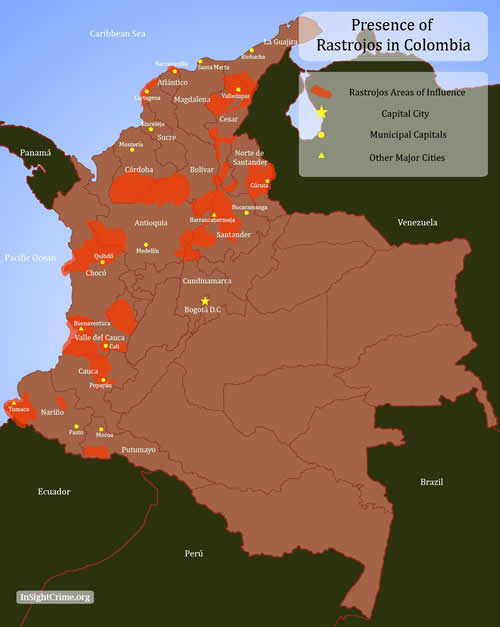The expansion of the group under its leader Luis Enrique Calle Serna, alias 'Comba,' has been exponential. In the last two years, it has left its traditional hub along the Pacific Coast and now operates in a third of Colombia’s 32 departments. The Rastrojos, who take their name from one of their militia leaders, are primarily engaged in exporting cocaine and heroin to international markets. At the local level, they are also involved in extortion and kidnapping. The Rastrojos move drugs primarily up the Pacific Coast to Central America and Mexico where they sell it to Mexican drug traffickers who take it to the United States. They also have control of one of the primary smuggling routes into Venezuela, which is a bridge for cocaine moving towards Europe and northwards into the US on aircraft and go-fast boats.
Origins
The Rastrojos started in 2002, as the armed wing for Wilber Varela, alias 'Jabon.' At the time, Varela was fighting a rival in the Norte Del Valle Cartel, Diego Montoya, alias 'Don Diego,' and Montoya’s private army, the 'Machos.' Varela lieutenant Diego Pérez Henao, alias 'Diego Rastrojo,' recruited its first members, hence the group took on his name. Later, in an attempt to enter peace talks the government was holding with paramilitary groups, the group called itself Rondas Campesinas Populares or Popular Peasant Patrols (RCP). Those paramilitaries, under the banner of the United Self Defense Forces of Colombia (Autodefensas Unidas de Colombia - AUC), signed a peace agreement in 2004, and finished demobilizing their troops in 2006. However, the government did not allow the RCP to participate in the negotiations. Internal fighting led to the murder of Varela in 2008, but his armed wing remained a powerful player in the drugs, extortion and kidnapping businesses.
Modus Operandi
With at least 1,200 soldiers and growing, the Rastrojos are rapidly expanding and are arguably the most powerful drug trafficking organization in Colombia. Their strongholds remain in the area where they formed: Valle del Cauca and Cauca departments along the Pacific Coast (see map). They also have a presence in Antioquia, Bolívar, Cesar, Chocó, Córdoba, Nariño, Norte de Santander, Putumayo, Santander and Valle del Cauca.

They are different than many other groups in that they do not necessarily try to control every part of the distribution chain but rather seek strategic alliances. These alliances include working with rebel groups and former right-wing paramilitaries alike to help them move their product. They also concentrate their forces along embarkation points, specifically, the border with Venezuela and the Pacific Ocean. Both points give them enough control over the drugs they are shipping or the chemicals they need to bring into the country.
Specifically, the Rastrojos have had an agreement with the National Liberation Army (Ejército de Liberación Nacional - ELN) for several years in the departments of Cauca and Nariño. More recently they obtained a similar agreement with the Revolutionary Armed Forces of Colombia (Fuerzas Armadas Revolucionarias de Colombia - FARC) in other parts of the country. In both cases, these alliances give the Rastrojos direct access to coca base, which provides them the raw material to convert into cocaine at very cheap prices. The Rastrojos' other ally, Daniel Barrera Barrera, alias 'El Loco,' has struck similar agreements with the FARC in other areas. Together the Rastrojos and Barrera have obtained a huge competitive advantage, one that has also led to strong partnerships with Mexican cartels.
The Rastrojos and Barrera move cocaine via go-fast boats and semisubmersibles from the Pacific side of their operation and airplane via the Venezuelan side. There is some evidence that these semi-submersibles may be being replaced by fully submersibles. In July 2010, authorities in Ecuador found a 33-meter submarine capable of moving at least 10 tons of cocaine. On the Venezuelan side, the airplanes appear to fly due north over Venezuelan territory, to avoid Colombian radar, until they are close to the Dominican Republic, then head due west until they reach Honduras or Guatemala where they land, offload and continue their journey north.
On the enforcement side, the Rastrojos rely on their experience, connections and recruiting. Their long battle with the Machos has given them the wherewithal to operate in rural and urban areas, where they’ve placed a number of militias and informants. They’ve also penetrated the police, many of them long-time partners of the group since the days of the Norte del Valle Cartel, and the army, with the help of Barrera, who has many informants and allies within that institution. Finally, they have recruited well, adding a plethora of young and experienced soldiers from the now defunct AUC.
The Rastrojos business model of seeking strategic alliances does not always work. They are fighting with the Urabeños, a rival gang that operates in the northwest of Colombia near the Panamanian border. It is also believed that Enrique Calle Serna, 'Comba,' is trying to eliminate the leader of the Oficina de Envigado, Maximiliano Bonilla, alias 'Valenciano,' so he can take over several of the stretches of the Caribbean Coast.
Resources